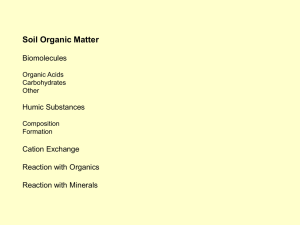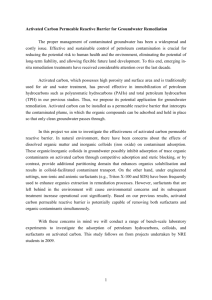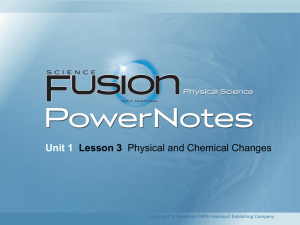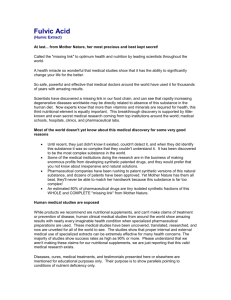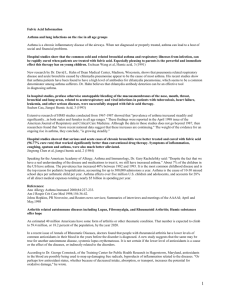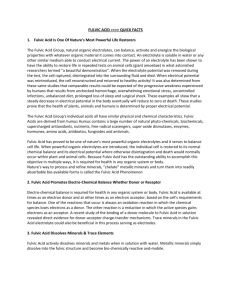Functions of Humic Substances for Turf
advertisement
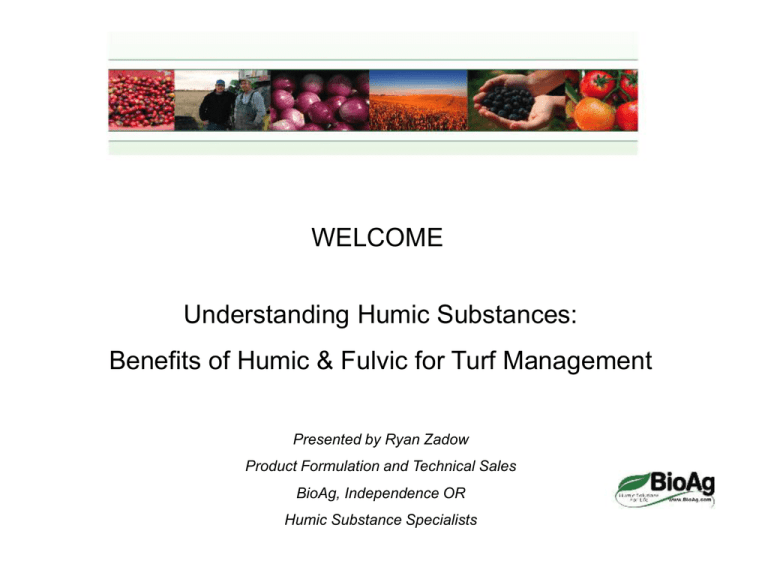
WELCOME Understanding Humic Substances: Benefits of Humic & Fulvic for Turf Management Presented by Ryan Zadow Product Formulation and Technical Sales BioAg, Independence OR Humic Substance Specialists Brief Nomenclature / Definitions 1. Organic Matter 2. Hummus 3. Humic Substances (RAW) 4. Humic Acid (alkali soluble) 5. Fulvic Acid (soluble across the whole pH range) 6. Humin and Mineral (insoluble) Brief Properties : Structure / Size Humic: soil conditioning fraction Fulvic: biological fraction Functions of Humic Substances in Agriculture There is a long list of positive effects that are well described in the scientific literature. Some are direct mechanisms and some indirect. Functions of Humic Substances for Turf Humic Acid : Soil conditioning fraction of humic substances A. Forms beneficial aggregates - improves air porosity - increases drainage or holding capacity - adds CEC / nutrient holding capacity - detoxifies soil: Sequesters heavy metals Buffers excess sodium / reduces high E.C. and pH Breaks down pesticide and herbicide residue Pulls apart hydrocarbons (oil & gas) Functions of Humic Substances for Turf Humic Acid : Soil conditioning fraction of humic substances B. Reduces leaching of nitrogen and extends it’s time in the root zone Functions of Humic Substances for Turf Humic Acid : Soil conditioning fraction of humic substances C. Releases bound Phosphorous - direct mechanism - Also through stimulation of beneficial microbes like b. megaterium and mycorrizhae Note: stimulation/balancing of the beneficial microbial biota and humic substance direct mechanisms go hand in hand. Functions of Humic Substances for Turf Fulvic Acid: biologically stimulating fraction A. Improves root structure and mass, especially adventitious roots. Functions of Humic Substances for Turf Fulvic Acid: biologically stimulating fraction B. Stimulates metabolism which leads to: - catalyzes nutrient uptake - increases respiration - improved rate of cell division Functions of Humic Substances for Turf Fulvic Acid: biologically stimulating fraction C. Chelation of micronutrients - prevents precipitation and tie-up - better releasing of micronutrients then “conventionals” like EDTA, etc… - increases fertilizer assimilation Functions of Humic Substances for Turf Fulvic Acid: biologically stimulating fraction D. Improves overall turf health which leads to: - relief from environmental stress, especially drought and frost damage.* - Improved resistance to : insect damage, viruses & pathogens *note- There is a ceiling effect and must be applied before pressure and continually. Functions of Humic Substances for Turf *note- There is a ceiling effect and must be applied before pressure and continually. Functions of Humic Substances for Turf *note- There is a ceiling effect and must be applied before pressure and continually. Functions of Humic Substances for Turf Fulvic Acid: biologically stimulating fraction E. Stimulates enzymatic functions: - RNA and DNA synthesis - catalysis of many biological synthesis pathways HumiSolve: Dry soluble humic/fulvic concentrate - only need a fraction compared to raw humic substances! - easier to handle than raw - immediately available for today’s turf - stable over time (liquid humic acid degrades) - contains both humic and fulvic - no heat processing for higher efficacy Ful-Power Fulvic Liquid: -compatible in all pH ranges (unlike the humic faction) -great for foliar applications -enzymatically extracted (replicates nature…who does it better?) …true fulvic not fulvate …contains beneficial microbes, enzymes, and phytostimulants -wetting agent (adjuvant) qualities and is effective penetrant …makes other sprayed materials more effective/amplified …helps pull other materials past the leaf membrane CONCLUSIONS: Materials that are environmentally responsible and an important part of sustainable soil management. Products that help pay for themselves by reducing inputs and stimulate soil life/biota. A few take home lessons: •*Improved turf health (color, consistency, better root structure, thickness) •*Resistance to environmental, and pest pressures (drought, insect, pathogenic, virus) • Helps efficiency of fertilizers and reduces their leaching: leads to higher performance at lower rates and increased savings. • Stimulates seed germination (rate and percentage).
